Who got invited, who got Canadian permanent residence, and how the pandemic affected Express Entry in 2020.
Source: CIC NEWS
The Express Entry Year-End Report 2020 was released on December 13, though in previous years it has been published in the summer. It shows us who got to immigrate to Canada through Express Entry, and how the pandemic affected Canada’s main immigration application system.
For starters, although Canada issued a record number of invitations to Express Entry candidates in 2020, the number of new permanent residents brought in through Express Entry dropped to a three-year low.
Normally, there are more permanent residents admitted than there are invitations issued, since one application can contain the principal applicant and their family members. However, in 2020, the pandemic caused Express Entry admissions to plummet below the level of ITAs. In 2020, Immigration, Refugees and Citizenship Canada (IRCC) issued more than 107,000 Invitations to Apply (ITAs), compared to 2019 when IRCC issued 85,300. Out of the ITAs issued in 2020, only 63,923 Express Entry applicants and their family members got permanent residence, whereas there were 109,601 new permanent residents admitted in 2019.
IRCC did not meet the processing standard of finalizing 80% of Express Entry applications within six months. The average processing time was nine months, which is one month slower than 2019. IRCC says about 51% of applications in 2020 were completed within the six-month standard. The following table is based on data that was up-to-date in January, 2021.
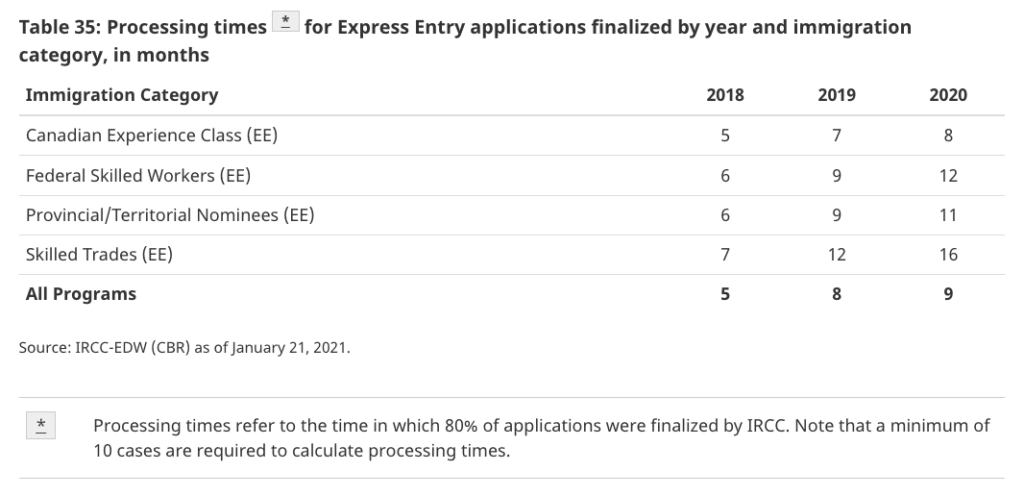
Because of the pandemic, IRCC increased the validity period of an ITA from 60 to 90 days to allow applicants to have more time to prepare their applications. Previous IRCC data obtained by CIC News say that 36% of Express Entry applicants between March 18, 2020 and April 6, 2021 used the extra time, whereas 49% still applied in the two-month timeframe.
Main source countries
IRCC concentrated its invitations to apply at candidates who were eligible for the Canadian Experience Class (CEC) and Provincial Nominee Program (PNP), as they are more likely to be physically located in Canada and less likely to be impacted by public health measures.
The proportion of Express Entry candidates invited to apply from inside Canada grew from 47% overall in 2019 to 63% overall in 2020. IRCC says this is due to the increased number of invitations issued to CEC candidates.
Although the proportion of candidates invited from India dropped to 10% in 2020 compared to 18% in the previous year, there were still more candidates invited from India than any foreign country.
The top six countries of residence for invitations remained the same as previous years: Canada, India, U.S., Nigeria, U.A.E., and Pakistan. Lebanon made the top 10 list for the first time since Express Entry was created in 2015.
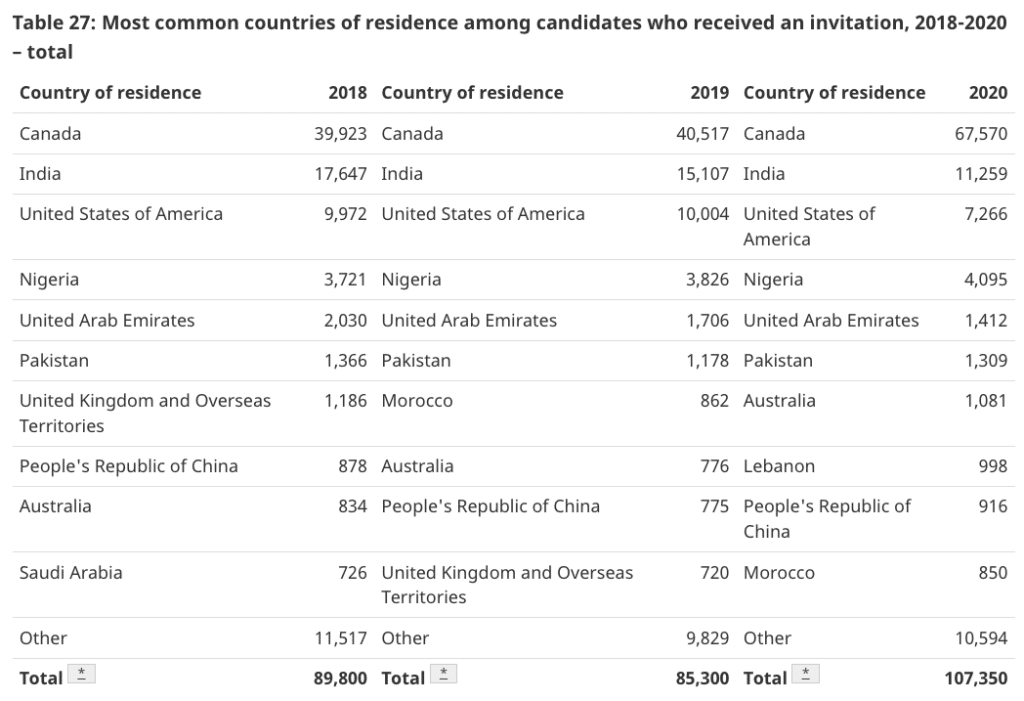
India was also the most common country of citizenship among those who received ITAs followed by China, Nigeria, Pakistan, and the U.K.
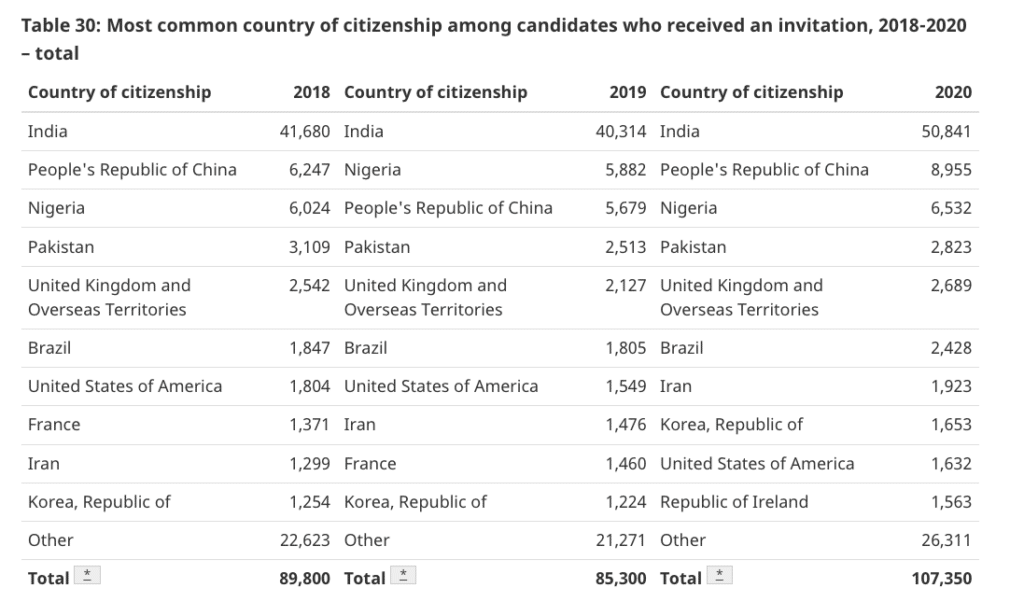
Still more men in pool but women make up growing share
As in previous years, more Express Entry profiles were submitted by men than women. However, the proportion of women in the Express Entry pool grew to 43% in 2020 compared to 41% in 2019.
Although fewer women were in the pool, their profiles were more likely to be eligible for at least one program, compared to men, which was consistent with the two years prior. IRCC reports 77% of women and 71% of men who submitted profiles were eligible for at least one program.
Among principal applicants who applied for permanent residence, a slightly higher proportion of men than women submitted applications in 2020. Both genders applied most often under the CEC and least often under the Federal Skilled Trades Program (FSTP).
In each program, men were more likely than women to submit applications. The difference was more pronounced under the FSTP and least pronounced under the Federal Skilled Worker Program (FSWP).
Tech talent leads the way
Once again, occupations in information technology, and business and financial services continued to dominate among candidates invited to apply for permanent residence. Special to 2020 though, more food service supervisors and administrative assistants received ITAs. IRCC says this is likely the result of holding more CEC-specific rounds of invitations.
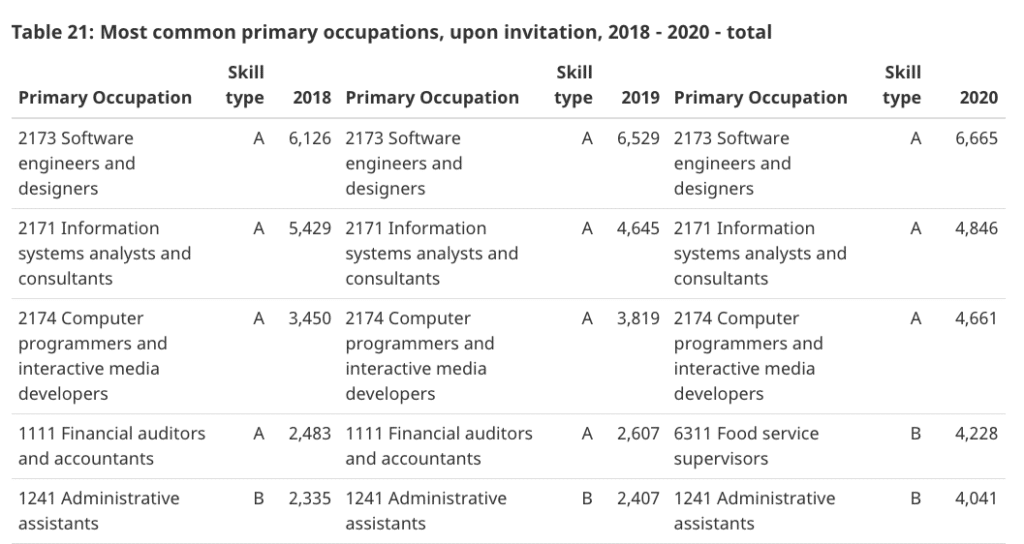
The most common occupations among candidates who got arranged employment points were food service supervisors and computer programmers. This is also new to 2020, and likely a result of the CEC draws.
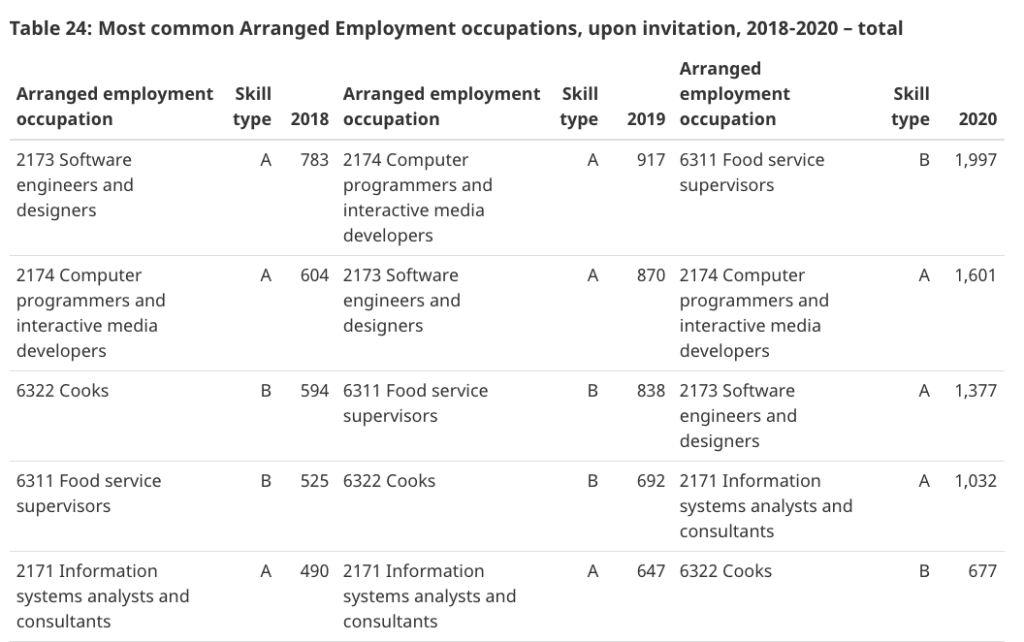
CRS breakdown
Although like previous years there were more candidates in the pool who had a Comprehensive Ranking System (CRS) score in the 351-400 range, an increasing number fell into the 451-500 range. The proportion of candidates with these higher scores increased to 27%, compared to 22% in 2019, and 18% in 2019. About 27% of candidates were in the 300-350 range.
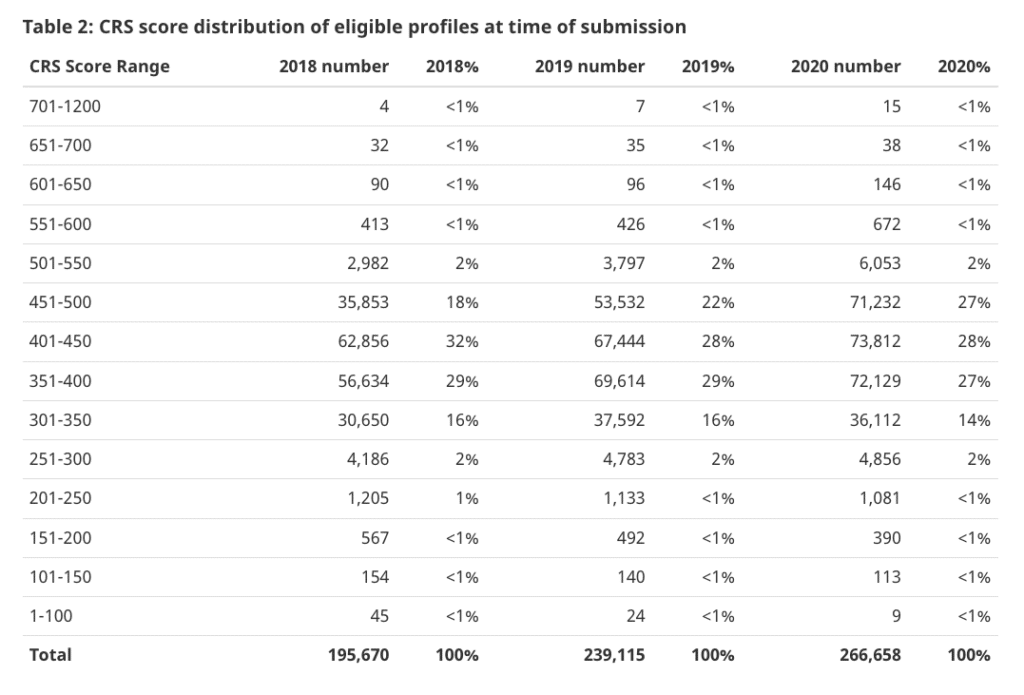
IRCC says 42% of invitations in 2020 went to candidates who had Canadian education, up from 28% in 2019. This is another result of the increase in CEC-only draws.
Out of the 37 rounds of invitation last year, IRCC held 21 that were program-specific: 10 CEC draws, 10 PNP draws, and one FSTP draw. Minimum CRS scores ranged from 687 to 808 for PNP-specific rounds, and from 431 to 467 for CEC-specific rounds. The one FSTP draw had a cut-off score of 415.
When looking only at all-program draws, the CRS cut-off score range in 2021 was slightly higher than 2019. Scores averaged to about 472 in 2020, compared to an average of 461 in 2019. This increase suggest that the Express Entry pool became more competitive in 2020 for FSWP candidates and FSTP, as a result of IRCC’s efforts to target CEC and PNP candidates.
In 2020, IRCC also increased the number of points available to French-speaking and bilingual candidates in the Express Entry pool. On October 20, 2020, the number of points awarded through Express Entry went up from 15 to 25 for French-speaking candidates, and from 30 to 50 for bilingual candidates. This change is intended to support Canada’s goal of increasing French immigration outside of Quebec to 4.4% by 2023, and improves French-speakers chances of receiving an ITA.
The proportion of candidates in the Express Entry pool who met criteria for additional points for being proficient in French went up to 5% in 2020 from 4% in 2019.
Ontario main destination
Nearly two-thirds of principal applicants who applied through Express Entry in 2020 named Ontario as their province of destination, slightly more than 2019. Also compared to 2019, the number of principal applicants who intended to move to Saskatchewan, British Columbia, and New Brunswick increased in 2020, while the number of applicants intending to reside in Alberta and Nova Scotia decreased.
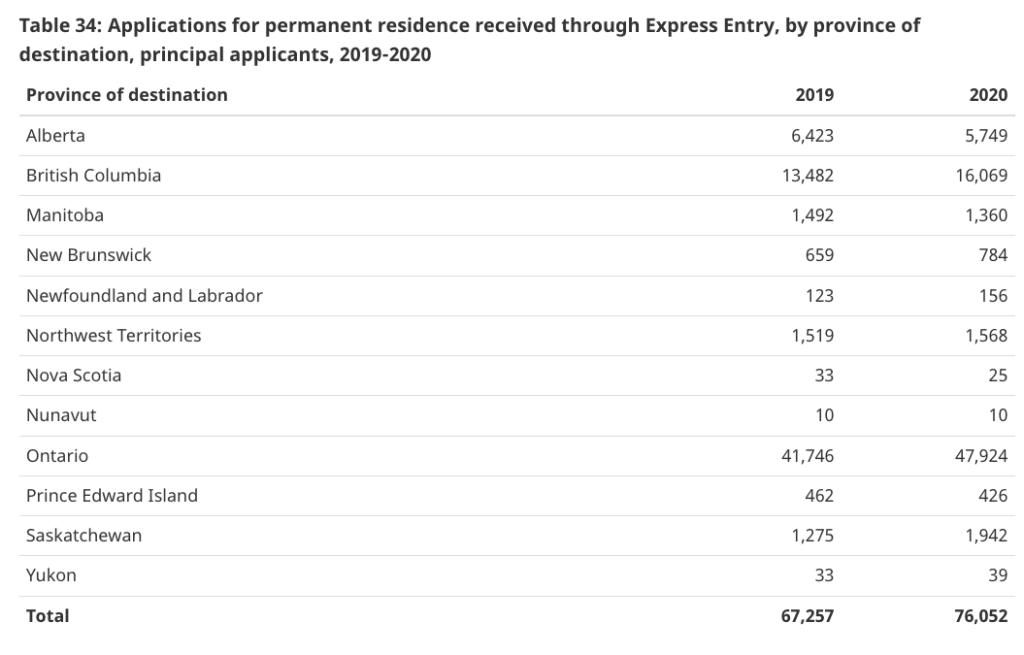
Much like the application stage, the majority of people who got permanent residence in 2020 were destined for Ontario.


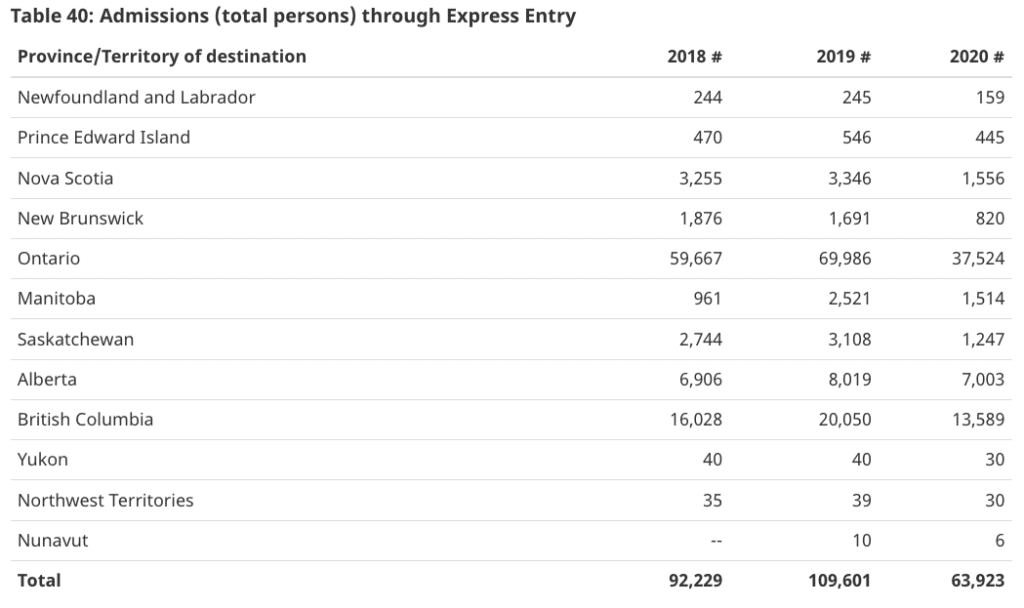
 info@clickimmigration.com
info@clickimmigration.com